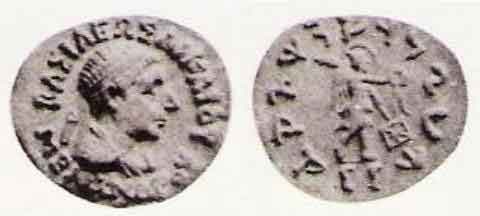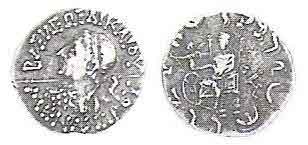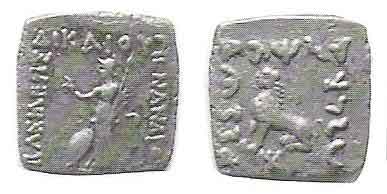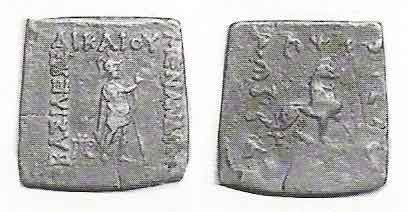.

Coin of Menander II.
Obv: Menander wearing a diadem. Greek legend: ΒΑΣΙΛΕΩΣ ΔΙΚΑΙΟΥ ΜΕΝΑΝΔΡΟΥ (King Menander the Just).
Rev: Winged figure bearing wreath and palm, probably Nike. The Kharoshthi legend reads MAHARAJASA DHARMIKASA MENADRASA (Menander, King of the Dharma).
Menander II "The Just" (reigned circa 90-85 BC) was an Indo-Greek King who ruled in the areas of Arachosia and Gandhara in the north of modern Pakistan.
It has been suggested that Menander was the son of Strato I, and hence the grandson of Menander I. Against this could be said that his coins show a vast variety of obverses, some of which were previously associated with other dynasties. This suggests that he was a new king who attempted to attract several fractions; the name Menander might well have been common due to the popularity of the first king.

Coin of Menander II with a depiction of an eight-spoked wheel.
Obv: Bust of king, diademed and holding a spear. The Greek legend "ΒΑΣΙΛΕΩΣ ΔΙΚΑΙΟΥ ΜΕΝΑΝΔΡΟΥ" (King Menander the Just).
Rev: Zeus seated on a throne, with Nike on his right arm, holding a wreath above an eight-spoked wheel. Kharoshti legend: MAHARAJASA DHARMIKASA MENADRASA (Menander, King of the Dharma).
A devout Buddhist
The coins of Menander II bear the mention "Menander the Just", and "King of the Dharma" in Kharoshti, suggesting that he adopted the Buddhist faith. They also depict the lion, symbol of Buddhism, as also seen on the pillars of the Mauryan King Ashoka. The presence of the Buddhist Dharma wheel has also been reported on one of his coins (Tarn). In general, the coins of Menander II are quite few, which tends to indicate a rather small rule.
The next king to represent the Buddhist lion on his coins is the Indo-Scythian king Maues, around 85 BC, after the end of Menander II's reign.
There is a possibility that Menander II, rather than Menander I, is actually the Buddhist Greek king referred to in the Milinda Panha. This point is unsolved however, since Greek sources (Plutarch (Praec. reip. ger. 28, 6)) relate that the great conqueror Menander I is the one who received the honour of burial in Buddhist stupas.
On the other hand, it also has been suggested that Menander II was not a separate king at all, but that, instead, Menander I changed his title to ΔΙΚΑΙΟΥ "The Just" in Greek, and "Dharmikasa", or "King of the Dharma" in Indian Prakrit, at the end of his life, following his conversion to Buddhism, which would be supported by the elder portraits found on Menander II's coins. It was however quite rare for a king to change his dynastic title, and the deity types found on Menander II's coins are quite different from those of Menander I: Athena with shield at her feet, Zeus sitting, a mounted king, or Nike standing. Menander II is by far the Indo-Greek king with the most comprehensive pantheon.
More likely, Menander I may indeed have first supported Buddhism, like the other Indo-Greek kings, and was probably the main protagonist of the Milindapanha, on account of his described fame, whereas Menander II, a minor king, may have wholeheartedly embraced Buddhism, as exemplified by his coins.

Coin of Menander II (Indian standard).
Obv: Athena standing, with spear and palm-branch, shield at her feet, making a benediction gesture with the right hand, similar to the Buddhist vitarka mudra. The Greek legend reads ΒΑΣΙΛΕΩΣ ΔΙΚΑΙΟΥ ΜΕΝΑΝΔΡΟΥ (King Menander the Just).
Rev: Buddhist lion. Kharoshti legend reads MAHARAJASA DHARMIKASA MENADRASA (Menander, King of the Dharma).

Coin of Menander II (Indian standard).
Obv: Warrior standing, armed with spear and sword. Forming a benediction with the right hand, similar to Buddhist vitarka mudra. Greek legend: ΒΑΣΙΛΕΩΣ ΔΙΚΑΙΟΥ ΜΕΝΑΝΔΡΟΥ (King Menander the Just).
Rev: Buddhist lion. Kharoshti legend reads MAHARAJASA DHARMIKASA MENADRASA (Menander, King of the Dharma).
Preceded by: Peukolaos
Indo-Greek Ruler (Arachosia, Gandhara) (90 - 85 BC)
Succeeded by: Archebios
Links
References
- "The Shape of Ancient Thought. Comparative studies in Greek and Indian Philosophies" by Thomas McEvilley (Allworth Press and the School of Visual Arts, 2002) ISBN 1-58115-203-5
- "Buddhism in Central Asia" by B.N. Puri (Motilal Banarsidass Pub, January 1, 2000) ISBN 81-208-0372-8
- The Greeks in Bactria and India (Cambridge Library Collection - Classics) , W.W. Tarn,
Greeks:
A - B - C - D - E - F - G - H - I - J - K - L - M -
N - O - P - Q - R - S - T - U - V - W - X - Y - Z
| Ancient Greece
Science, Technology , Medicine , Warfare, , Biographies , Life , Cities/Places/Maps , Arts , Literature , Philosophy ,Olympics, Mythology , History , Images Medieval Greece / Byzantine Empire Science, Technology, Arts, , Warfare , Literature, Biographies, Icons, History Modern Greece Cities, Islands, Regions, Fauna/Flora ,Biographies , History , Warfare, Science/Technology, Literature, Music , Arts , Film/Actors , Sport , Fashion --- |
Retrieved from "http://en.wikipedia.org"
All text is available under the terms of the GNU Free Documentation License

